Genre: Shmup Developer: Victor Ent. Publisher: JVC Players: 1 Released: 1993
Deep in a mountain north of the capital city lived the descendants of the Ancient Gods, protecting their ancestor’s secret treasure. Down through the ages their numbers have dwindled. Now there remained only an old couple with their granddaughter Rami. They alone kept watch over the treasure of the Ancient Gods. One night, a flying wooden ship appeared suddenly from the sky and attacked! It was Dr. Pon who had attacked and stolen the key to the secret treasure!
With this said and done, Rami is off to go get the key from the bad Dr. Pon. The story is great and has some pretty standard but good anime. The voice dubbing was also done very well. There are some occasional cut scenes between levels and they are dubbed well also. I only wish they had dubbed Rami’s voice for the “in-game” parts as those were left in Japanese. I can certainly understand if JVC didn’t have the time to do ’em, especially if they were on a tight budget, so I’m happy with what I got out of it overall. Absolutely no major complaints for the story, animation, or English dubbing for all the cinema intermissions.
Keio Flying Squadron is your typical, very basic, bare bones, side-scroller. It has seven levels which are about equal in length, usually containing a mini-boss, maybe two if you’re lucky, and then an end boss. Beyond that, there is not much else, but what is given is just plain, good ‘ol fashion fun.
The weapons for Keio are fairly run-of-the-mill, but useful nonetheless. A few power-ups are gained by killing a certain type of enemy (yellow and greenish looking fellow) and obtaining the icons he drops. The first two upgrades are for the main shot, made possible by continuing to get the same icon in a row. The single shot flame icon makes the standard shot grow bigger in size and a slight bit stronger, but the main advantage here is the wider shot it gives, making it easier to hit enemies. This can be upgraded several times before it is maxed out. The other flame icon is a spread shot. In its infancy, it is very weak and only shoots out in two directions. As it is upgraded, it will become a much larger spread shot with more bullets from two, three, then five shots. The disadvantage is that it has a very slow firing rate.
Rami and Spot are also not without some standard, run-of-the-mill secondary weapons as well. A bomb icon will give her the ability to drop those nice little round bombs onto enemies below (ala Gradius style), complete with a fuse and sparks to boot. Another is the dragon icon which will change the bombs into little homing dragons (like homing missiles) that seek out and destroy the closest enemy on screen. Once again, as the same icon is gained, the more of it can be shot on screen at time (up to five). Lastly, the secondary weapon can also be changed to a cluster mine that will fire away from Rami in the opposite direction in which the D pad is pushed. This can be helpful on bosses or tight areas that give little room to move.
Let’s not forget the options either. Options in this game are gained and used a little differently than other shooters, giving this game another notch for originality. Rami gains options not by icons or power-ups, but whenever she stops shooting. A silhouette of a little flying green dragon will appear and slowly fade in completely to be used as an option. If Keio fires before the dragon is completely present, it will disappear and the process will start over. Once an option is present, it’s there to stay. She can do this again to gain one more, allowing for the standard two options like most shooters. The other part about the options that is cool is that they can be sacrificed in a sort of “blaze of glory.” By hitting the C button, a dragon will shoot out copies of itself across the screen in a spread pattern and take out everything or do some major damage! This option will be lost, but it can be re-obtained by the above-mentioned method.
Another small but neat aspect of the game is how some 1ups can be gathered. 1ups are gained by completing some sort of task or skill. For example, destroying all the turrets that come out of the huts on the ground will present a floating 1up icon at the end of the screen after the last one is destroyed on level one. The same goes for level five, where there are several huge orange cannons at the beginning of the level. If all are destroyed, a 1up will appear! There is also another way to get 1ups and that is where the occasionally one might be hidden. In level 2, for example, there is a small little whale going up a waterfall on the left side of the screen while Rami is flying down. If she hugs the waterfall and touches the nice big fish… Ding! Another chance to play on…
A nice part of the game is the old style, hand drawn graphical art. A good amount of color was used and all the characters, backgrounds, and enemies are drawn nice and big so you can see their animations as they come across the screen, giving the game that full cartoonish image. There are also various types of enemies from animals to navy ships, or even wooden boats flying through the sky with raccoons paddling with oars, etc. From mini bosses to main bosses the artwork contains the nice, cute, hand drawn look of the old school shooters. Obviously, this presents a sign of the times as this is one of the last done before the 32/64-bit revolution came.
Another part that makes this game fun is just enjoying all the simple and colorful enemy characters that are kind of goofy to see. Like I already mentioned, seeing those stupid little raccoons rowing little wooden boats in mid-air, frogs with raccoons on them jumping out of water, huts that open up into turrets, etc. are just some of the commonplace elements seen throughout the stages. It’s just plain damn goofy and I liked it. Those damn raccoon followers of Dr. Pon are seen just about everywhere, armed with slingshots, flying pigs, cats, machinery, flying contraptions and more. Simple? Yes. Does it fit the game well though? You bet.
The game has some cinema intermissions for the beginning of the game, along with some colorful still images in between levels. This makes the game a little more enjoyable, especially for Japanimation fans. There is a little minor element of slowdown present in the game too. Although there is a little bit throughout the game, depending on the area and how powered-up Rami is, the slowdown in general is pretty minor when considering this type of game, especially because it doesn’t cause any serious flicker. What is presented is good enough and major gripes about the game cannot be said. What you see is what you get, and it’s good enough for me.
The music in Keio Flying Squadron is very good and has some great little themes. Stage one is probably one of the best and most memorable. Another great attribute this title has that few shooters or any other games has is that the music tracks for the levels are over 4 minutes long! This prevents tracks from repeating often like other CD-ROM games that only contain music that can be made to sound very annoying for one major reason: They are only about a minute or so long before those tracks repeat.
Sound effects are about what anyone can expect by just looking at the cover box or pictures. What can I say? The sounds are there. Most are nothing super-fantastic or out of the ordinary. A few sounds are present that help maintain the game’s humor. There is the occasional sound of a cow (from the first boss) who is pulling the huge cart onto the screen and keeps mooing every time it gets hit on the head with a bomb. Other sounds are just plain cartoonish and fit the theme of the game, like the sound of Rami’s squeak when she gets hit by a bullet or the death of a boss or certain kind of critter. I did like shooting the flying cats. Hey, they meow. Guess they don’t like bullets or water directed at ’em.
Then there is Keio’s voice. Like I mentioned before, the original Japanese voice was left in for the in game character and you can occasionally hear Rami speak (when getting to a certain area, getting hit, firing a certain attack, or arriving at a boss). The voice is cute and JVC didn’t change it. Although I would not have minded if they did as the cinema sequences were dubbed quite well. Overall though, the sounds for explosions, bombs dropping, firing and such are pretty standard with a few small and cute touches here and there that add to the game (albeit small, but sweet.)
The challenge level of the game is not anything fantastic. It’s kept at a pretty bare bones and simplistic level of difficulty. So in other words, the game leans toward the “fairly easy to beat” side of the spectrum. So, if you like the game enough to want to play it, then it is highly recommended that the difficulty of the game be immediately increased to hard, so perhaps, someone will get a chance to play the game an extra day (maybe). It is also advised, including amateurs, to not use the continue feature to make the game last. Although there are seven levels, which is not bad for the length of a game, if you want the game to last a little bit longer, say, a couple of hours tops, DON’T continue. The point I’m trying to get across the table is that if there are people out there that cannot finish this game without continuing, then I’d be very scared to meet them. They probably have a mental handicap. That’s the only excuse that could be tolerated.
Keio Flying Squadron is a rare, different, and goofy little shooter to have for a good laugh. It’s simple to play, yet a solid game. While it certainly does not appeal to everyone, especially those into the heavy sci-fi themes of other shooters, it is still a fun little parody on its own. The story is cute and funny, with some simple, but good Japanimation nicely dubbed, along with solid gameplay with a fair challenge rate. The graphics and characters are made big and colorful to reflect the entire image of the game accurately. With the fair amount of options available, the game can be played by the hard-core folks just to say they finished another game (without continuing is advised of course) and still have some fun. The supply of enemies is not huge but the game gives a fair amount to kill. Whoever the hell was at JVC sure did pick an odd title to translate, but at least they got the right voice actors for the English dialogue. As a result, it has made the game much more enjoyable for the story and helped the overall game’s theme. It’s a nice small game, but don’t spend more than ten to twenty bucks on it at most.
Originally printed on Starbase 299.
SCORE: 6 out of 10

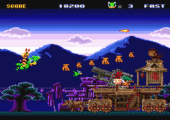
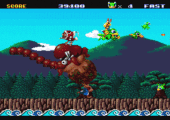
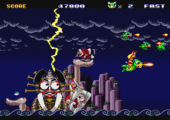
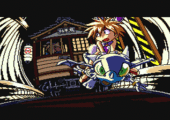
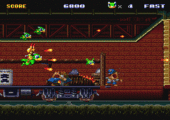
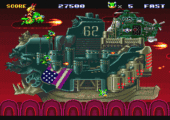
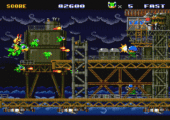
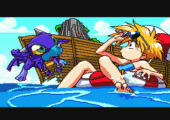
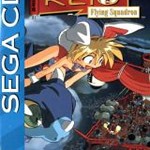
I like how this review from 10 years ago says don’t spend more than 20 dollars on this game. Right now on eBay someone wants 450 dollars. The times they are a changin’
6 months later, and the sole NTSC-US copy is now in NEO GEO territory at $770.